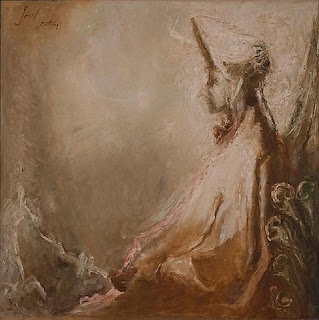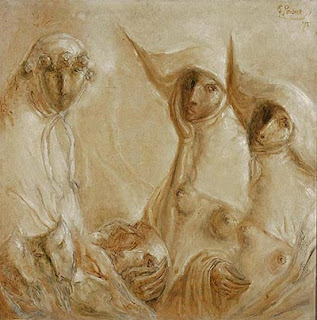Fidelio Ponce. Was born in 1895, Camaguey and dies on February 19th, 1949, Havana.
Initiated studies in San Alejandro from 1913 through 1918, year in which disappeared until 1923. He moved to a suburb neighborhood where he teaches drawings to poor kids and works on commercial arts.
His first exhibitions at the Lyceum, becomes a great success for him. His work "Las Beatas" is awarded with a prize from El Salon Nacional, as well as prizes from El Salon de Arte Moderno in Havana, in 1937. At this time his career is in a roll; traveled to New York and open exhibitions in the Delphis Studio. Again, received first prize for his work "Los Niños" from the Salon Nacional, and then disappeared until 1940. The Museum of Modern Art in New York obtain his work: "Mujeres" as part of its permanent collection.
Ponce, which had a great personality, was a student of Romañach and his work was influenced by his academic procedures. Today his paintings are a disaster. Much of the colors are gone and the surfaces are cracked. He never took great care with his work, neither knew how to, since never learned methods for preparing the oils adequately. He was obsessed with the white color, which he used to call "pintura nacarada" in order to project light color from it. He enjoyed Kandinsky's famous words: "...white is a great silence full of possibilities.."
Samples of Fidelio Ponce's Works:
 |
| Fidelio Ponce Katrina |
 |
| Fidelio Ponce Dos Mujeres |
 |
| Fidelio Ponce Beatas |
 |
| Fidelio Ponce El Lago |
 |
| Fidelio Ponce Dos Mujeres |
http://www.thefarbercollection.com/artists/bio/fidelio_ponce_de_leon
Fidelio Ponce is a unique figure in the context of modern Cuban art. At a moment when common interests among various groups gave the Cuban modernist movement a particular coherence, Ponce remained isolated—a solitary artist whose work seemed infused by his most intimate concerns and a highly personal spirituality. Nourished by themes of the Decadent movement in Europe and Latin America, his art lacked any visible trace of cubanidad or attempts to express Cuban “local color,” which at the time was considered a mission of sorts among the island’s artists. In a manner not unlike Venezuelan painter Armando Reverón, Ponce sought to express himself through shades of white, nuanced by other pale hues, in this way creating his most outstanding works.
Ponce burst upon the art world in 1934 with his first, and definitive, solo exhibition at the Havana Lyceum. From that point he became a surprisingly major name in modern Cuban art, and his works were quickly considered “classics.” His modern paintings were strongly rooted in tradition, as far removed from academic orthodoxy as from avant-garde defiance. Mexican artist David Alfaro Siqueiros, during his 1943 sojourn in Havana, referred to Ponce as a “powerful, singular personality, whose extremely individual style seems to come from a place beyond time and space.”
Ponce’s choice of subject matters was universal: landscapes, portraits, still lives, scenes from the Bible or inspired by mysticism. As Ramón Vázquez—one of the leading experts in his work—has pointed out, Ponce’s art had “deep romantic roots underlying a modernist vocation, channeled through what Alfred H. Barr, director of New York's Museum of Modern Art, called an ‘intuitive expressionism.’” Barr himself, when organizing MoMA’s Modern Cuban Painters show in 1944, had this to say of Ponce: “in his best moments he is the foremost painter in Cuba, veiling his disconcerting figures in soft shades of sienna, white and green.”
It is also in this context that we should place his superb drawings, which represent a substantial part of his oeuvre. Drawings that are veritable masterpieces grace the collection of the National Museum of Fine Arts in Havana as well as private holdings. Though most are done on paper of more than humble quality, Ponce’s drawings are in the same league as his best paintings. Such is the case of La Espera (Waiting), with its tremulous, intense line—a magnificent example of Ponce’s draftsmanship. The lines flow naturally, swelling until they reach their definitive form, a challenge for any artist daring enough to try to imitate them. Ponce’s genius shines through all his work, with both his paintings and drawings showing the same matchless, unmistakable style.
Pierre Loeb, the brilliant French art critic who sought haven in Cuba during the harshest years of World War II, cleverly pointed out Ponce’s exceptionalism within the context he lived in: “It is true that modern times present other problems and other concerns,” he wrote, “but Ponce will always be honored for having sung his own song, for having managed to express in his work his most intimate personal struggles, and for having given us all the example of a man of peerless quality and nobility.”
—Roberto Cobas Amate

De mis favoritos...
ReplyDelete